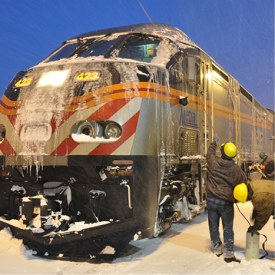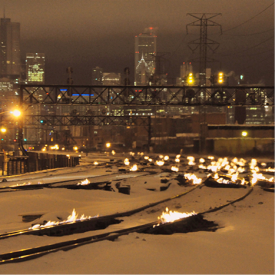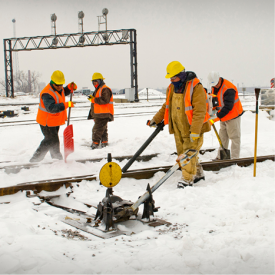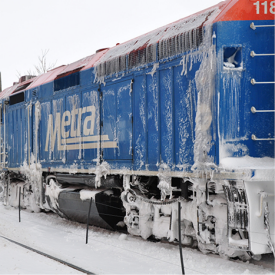Getting Ready for Winter Weather
Snow, ice and subzero temperatures make winter travel a challenge for everyone in Chicago – including Metra. But we do everything we can to make sure My Metra is running for you. The following information is intended to help our passengers better understand Metra’s challenges during severe winter weather, how it can impact service and what you can do to better prepare when snow and ice are in the forecast.
Severe weather can affect Metra’s ability to keep our trains running on time and, in extreme cases, may force us to reduce our schedule of service. Your safety is always our primary concern and all operations decisions are made with safety as the primary focus.
Click on the video below to see how Metra prepares for and responds to winter weather.
Know Before You Go
Metra understands the importance of providing reliable, real-time communications to help our customers make decisions about their travel options during severe weather and offers a number of tools to give them access to the most up-to-date service information.
- Email alerts – Customers can sign up to receive service alerts via email for a specific rail line during the times of day that are most important to them. Click here to create an account and sign up for alerts.
- Ventra App – Customers can download the app and use the Transit Tracker for information about Metra trains, Pace buses and CTA trains and buses. The free app is available in the App Store or Google Play.
- Service Alerts – Customers can access real-time information about train status and service alerts via the this page.
- Twitter – Customers can follow each of Metra’s 11 rail lines or receive more general information about agency operations. For general Metra tweets, go here. Or click on the following links for individual lines: UP North, Milwaukee North, North Central Service, UP Northwest, Milwaukee West, UP West, BNSF, SouthWest Service, Heritage Corridor, Rock Island and Metra Electric.
- Passenger Services – Customers can call 312-322-6777 weekdays from 8 a.m. to 5 p.m. with questions about train schedules and service. On evenings and Saturdays, call the RTA Travel Information Center at 312-836-7000. Calls are answered from 6 a.m. to 7 p.m. Monday through Saturday.
Other tips for traveling on Metra during winter weather:
- Visit the National Weather Service website for the latest weather and storm-related information.
- Watch local television and listen to local radio stations for Metra travel and service updates.
- Give yourself plenty of time to travel to the station and park.
- Use caution when walking on wet or icy station platforms.
- If you are already traveling, listen for announcements at stations and on board trains.

Extreme Weather/Snow Schedules
Metra has prepared alternative schedules that may be implemented when extreme weather conditions or serious service disruptions do not allow for regularly scheduled service. These schedules represent, on average, about 75 to 80 percent of Metra’s normal weekday service. The purpose of the alternative schedules is to give Metra more flexibility to handle the impact of serious service disruptions while still helping you get to your destination. When the decision is made to implement alternative schedules, Metra will provide advance notice via its website, email alerts, Twitter and the Chicago area news media. To view the alternative schedules, click here.

Challenges We Face
Even with the best planning, issues do arise that can result in multiple train delays depending upon when and where a problem occurs. Below are some of the more common winter weather issues that may impact Metra service.
Frozen Switches/Switch Failure
Switches allow trains to move between different sets of tracks and are placed at numerous locations across the system. Snow and ice build-up can block and freeze a switch and prevent it from working. If a switch is blocked and the moveable part does not make contact with the rail, our signal system prevents a potential derailment by turning the signal red and stopping train movements in that area. To minimize snow and ice build-up, heaters are installed on all switches where commuter service operates. Metra has also installed switch shields on more than 50 of its most critical switches to further protect the switching mechanisms from the elements.
Even with heaters and shields, switches are still vulnerable to being clogged by snow and ice falling from the underside of locomotives and railcars. When this occurs, the switch must be cleared manually. Metra routinely assigns maintainers to key switching locations around the clock during storms to keep switches clear.

Clearing Our Rail Yards
Keeping the yards, where trains are stored and serviced, clear of snow and ice is also critical to maintaining reliable service. Blocked switches and tracks restrict train movements, resulting in congestion and preventing trains from reaching their originating stations in a timely manner. Following the 2014 Polar Vortex, Metra installed switch heaters in our coach and service rail yards. In addition to the switch heaters, Metra uses high-powered hot-air jet blowers and cold-air blowers in the yards to clear the snow and prevent blowing and drifting. The truck-mounted cold-air blowers clear ice and snow with a 525-mph blast. Capable of traveling over roads or rails, this versatile tool can quickly clear significant amounts of snow.

Locomotive and Railcar Breakdowns
Snow and subfreezing temperatures can affect our cars much like they affect yours. Ice and snow can damage the hoses and cables that supply the train’s onboard power, communications and braking systems, accelerate wear and tear on a train’s brake shoes and wheels and collect in the railcar doors, preventing them from opening and closing properly.
Crews and mechanical staff inspect trains daily and perform a number of federally regulated operational tests during midday servicing and before each departure. Additional procedures to monitor key components are also implemented during the winter months. If defects are found, they are repaired before a car can be returned to service.
To prevent mechanical problems from developing, and to allow more time for midday inspections and repairs, we keep locomotives powered up and refuel them in outlying yards overnight when the temperature drops below zero. We also have a program to repair and replace railcar doors that are prone to fail during winter conditions.
Signal Problems
The electrical wiring that powers our signaling system is also very vulnerable to extreme cold and drifting snow. For the safety of our passengers and employees, the signal systems are designed to operate in a failsafe mode and trains are required to stop any time a signal goes red or dark. When storms are forecast, signal maintainers are stationed at key locations to reduce response time and train delays.
Salt used to melt ice can also create problems by disrupting electrical circuits and cause crossing gates to remain in the down position. Frost can also disrupt electrical contacts and affect crossing gates and train signals. Trains may be required to stop or proceed at a reduced speed through a crossing until repairs can be made.
Broken Rail
Steel rail is strong and durable but extreme cold can cause the metal to become brittle ̶ especially at welded joints or at the location of small defects in the rail that can develop over time. In very cold conditions the rails are under a lot of tension and more vulnerable to breaking at a defect when trains pass over them.
Most of the Metra system is made up of continuously welded rail, which decreases the number of welded joints vulnerable to breakage. To minimize the impact of rail breaks or other rail defects on our system, all Metra-owned tracks are inspected on a twice-weekly basis at minimum (every three days). Specialized trains equipped to analyze the conditions of our track, including ultrasonic scans for internal defects in the rail, are conducted twice a year. When defects are found repairs are made as soon as possible, usually overnight.
Broken rails can impact our service in two ways. First, trains must be rerouted or proceed through the break site at greatly reduced speeds. Second, broken rails disrupt the electric circuits that control our signal system, forcing our signals to turn red, stopping the trains. Depending upon the severity of the break, trains can proceed across a broken rail under the direct supervision of qualified personnel.
Train Boarding
More customers are likely to use Metra trains when the weather is severe. The addition of just 10 more people on each train can increase boarding time and cause trains to fall behind schedule. Crews are dispatched to clear snow and salt walkways and stairs, but these areas can still be slippery and may need to be cleaned multiple times during a major storm. Please remember to use caution while approaching the train platform and also allow extra time to board.
Extreme cold can also slow our trains. In general, Metra reduces the speed of its trains when air temperatures drop below zero to reduce stress on the track infrastructure. Since our train schedules are tightly configured, any reduction in speed can put our trains behind schedule. The specifics of these speed restrictions vary from railroad to railroad, as each is responsible for determining its requirements for safe operations.